-
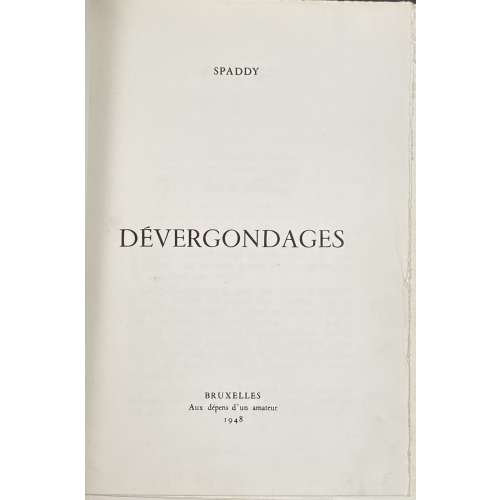 Description: single volume 24.5 x 19 cm, collated 4to, bound by a previous owner in quarter red morocco over marbled boards, raised bands, with gilt lettering in compartments: "SPADDY | DÉVERGONDAGES", red marbled endpapers. Printed on wove paper with watermark “RIVES”. Title-page: SPADDY | DÉVERGONDAGES | BRUXELLES | Aux Dépens d'un Amateur | 1948 || Pagination: [4] – blank, [1, 2] – h.t. / limitation, [3, 4] – t.p. / blank, 5-151 [152] – blank, [4] – blank; uncut, illustrated with 16 hand-coloured lithographs extraneous to collation after watercolours by Féodor Rojankowski [Rojan]. Table of contents on p. 151. Limitation: 250 copies of which №№ I – XVI with original watercolour and b/w suite of plates and №№ 17-250 on Rives paper with coloured lithography; this copy is № 100 of 234 Rives paper copies. Catalogue Raisonné: J.-P. Dutel (1920–1970) № 1389 / p. 128.
Description: single volume 24.5 x 19 cm, collated 4to, bound by a previous owner in quarter red morocco over marbled boards, raised bands, with gilt lettering in compartments: "SPADDY | DÉVERGONDAGES", red marbled endpapers. Printed on wove paper with watermark “RIVES”. Title-page: SPADDY | DÉVERGONDAGES | BRUXELLES | Aux Dépens d'un Amateur | 1948 || Pagination: [4] – blank, [1, 2] – h.t. / limitation, [3, 4] – t.p. / blank, 5-151 [152] – blank, [4] – blank; uncut, illustrated with 16 hand-coloured lithographs extraneous to collation after watercolours by Féodor Rojankowski [Rojan]. Table of contents on p. 151. Limitation: 250 copies of which №№ I – XVI with original watercolour and b/w suite of plates and №№ 17-250 on Rives paper with coloured lithography; this copy is № 100 of 234 Rives paper copies. Catalogue Raisonné: J.-P. Dutel (1920–1970) № 1389 / p. 128. -
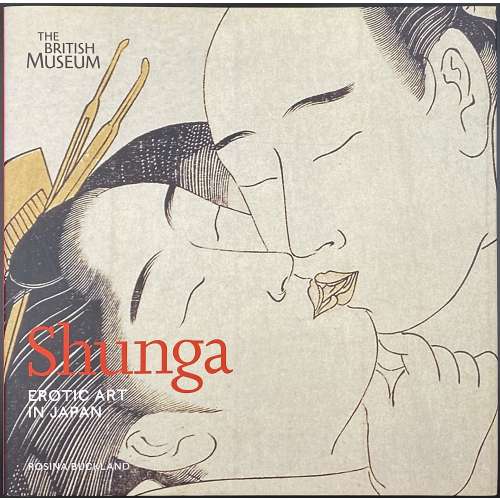 A hardcover pictorial album, 25 x 25.5 cm, bound in black buckram with silver lettering to spine, in pictorial dust jacket; pp.: [1-6] 7-175 [176 blank], total 88 leaves, illustrated in colour throughout. Title-page: Shunga | EROTIC ART | IN JAPAN | ROSINA BUCKLAND | THE BRITISH MUSEUM PRESS || Subject: Art, Japanese – Edo period, 1600-1868; Erotic art – Japan; Prints, Japanese – History. Contributor: Rosina Buckland (British, b. 1974)
A hardcover pictorial album, 25 x 25.5 cm, bound in black buckram with silver lettering to spine, in pictorial dust jacket; pp.: [1-6] 7-175 [176 blank], total 88 leaves, illustrated in colour throughout. Title-page: Shunga | EROTIC ART | IN JAPAN | ROSINA BUCKLAND | THE BRITISH MUSEUM PRESS || Subject: Art, Japanese – Edo period, 1600-1868; Erotic art – Japan; Prints, Japanese – History. Contributor: Rosina Buckland (British, b. 1974) -
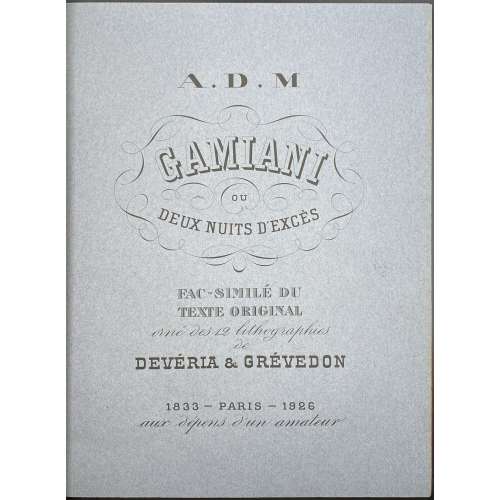 Description: ¾ contemporary red morocco over marbled boards, 33.1 x 25.8 cm, raised bands, gilt lettering to spine, in a marbled slipcase 34.2 x 25.9 cm. Printed on thick wove paper watermarked “MONTGOLFIER ANNONAY” by Canson & Montgolfier (Annonay, France). Front wrapper and title-page : A. D. M. | GAMIANI | OU | DEUX NUITS D’EXCÉS | FAC-SIMILE DU | TEXTE ORIGINAL | orné des 12 lithographies | de | DEVÉRIA & GRÉVEDON | 1833 – Paris – 1926 | aux dépens d'un amateur || Faux-t.p. (1): GAMIANI | OU | UNE NUIT D’EXCÉS | {vignette} | Bruxelles | 1833 || (fac-semilé of the original wrapper of 1833) Faux-t.p. (2): GAMIANI | OU | DEUX NUITS D’EXCÉS | {vignette} | Bruxelles | 1833 || (fac-semilé of the original wrapper of 1833) Collation: 2 blanks, 1 orig. lavender blue colour front wrapper, 1 blank, 1 h.t., 1 limitation p., 1 t.p., 3 leaves ‘Notice Bibliographique’, 32 leaves of printed text, 2 blanks, 1 brown faux t.p. (1), text in fac-semilé manuscript (7 leaves) with 8 coloured plates, 1 blank, 1 brown faux t.p. (2), 7 leaves of text with 4 plates, 2 blanks, brown back wrapper, lavender blue back wrapper, 2 blanks; total 64 leaves plus 16 plates. Pagination: [1-8] 9-75 [76] [4]; [1] 2-26; mispaginated p. 23 marked 25, f.t.p. and ffl not counted. Last four plates without letters. Limitation: a print run of 360 copies, of which 20 with ‘miniatures’ №№ 1-20, 100 with coloured plates №№ 21-120, 230 with b/w plates №№ 121-350; 10 copies not for sale, marked H. C. (hors commerce). This is copy № 201, which should be with black lithographs, but has coloured plates. According to J.-P. Dutel, the plates were printed from the original stones. For variations on Devéria & Grévedon designs for Gamiani see also: LIB-3087.2022 (Bruxelles, 1864); LIB-3093.2022 (Bruxelles, 1866); LIB-3090.2022 (Bruxelles, 1871); LIB-2902.2021 (Greman, 1911); LIB-2903.2021 (late 1940s). Catalogue raisonné: Dutel III 1640, p. 185. Contributors : Alfred de Musset (French, 1810 – 1857) – author. André Warnod [André de Sermanmagny] (French, 1885 – 1960) – author (bibliographical note) Pierre Louis Henri Grévedon (French, 1776 – 1860) – artist. Achille Devéria (French, 1800 – 1857) – artist.
Description: ¾ contemporary red morocco over marbled boards, 33.1 x 25.8 cm, raised bands, gilt lettering to spine, in a marbled slipcase 34.2 x 25.9 cm. Printed on thick wove paper watermarked “MONTGOLFIER ANNONAY” by Canson & Montgolfier (Annonay, France). Front wrapper and title-page : A. D. M. | GAMIANI | OU | DEUX NUITS D’EXCÉS | FAC-SIMILE DU | TEXTE ORIGINAL | orné des 12 lithographies | de | DEVÉRIA & GRÉVEDON | 1833 – Paris – 1926 | aux dépens d'un amateur || Faux-t.p. (1): GAMIANI | OU | UNE NUIT D’EXCÉS | {vignette} | Bruxelles | 1833 || (fac-semilé of the original wrapper of 1833) Faux-t.p. (2): GAMIANI | OU | DEUX NUITS D’EXCÉS | {vignette} | Bruxelles | 1833 || (fac-semilé of the original wrapper of 1833) Collation: 2 blanks, 1 orig. lavender blue colour front wrapper, 1 blank, 1 h.t., 1 limitation p., 1 t.p., 3 leaves ‘Notice Bibliographique’, 32 leaves of printed text, 2 blanks, 1 brown faux t.p. (1), text in fac-semilé manuscript (7 leaves) with 8 coloured plates, 1 blank, 1 brown faux t.p. (2), 7 leaves of text with 4 plates, 2 blanks, brown back wrapper, lavender blue back wrapper, 2 blanks; total 64 leaves plus 16 plates. Pagination: [1-8] 9-75 [76] [4]; [1] 2-26; mispaginated p. 23 marked 25, f.t.p. and ffl not counted. Last four plates without letters. Limitation: a print run of 360 copies, of which 20 with ‘miniatures’ №№ 1-20, 100 with coloured plates №№ 21-120, 230 with b/w plates №№ 121-350; 10 copies not for sale, marked H. C. (hors commerce). This is copy № 201, which should be with black lithographs, but has coloured plates. According to J.-P. Dutel, the plates were printed from the original stones. For variations on Devéria & Grévedon designs for Gamiani see also: LIB-3087.2022 (Bruxelles, 1864); LIB-3093.2022 (Bruxelles, 1866); LIB-3090.2022 (Bruxelles, 1871); LIB-2902.2021 (Greman, 1911); LIB-2903.2021 (late 1940s). Catalogue raisonné: Dutel III 1640, p. 185. Contributors : Alfred de Musset (French, 1810 – 1857) – author. André Warnod [André de Sermanmagny] (French, 1885 – 1960) – author (bibliographical note) Pierre Louis Henri Grévedon (French, 1776 – 1860) – artist. Achille Devéria (French, 1800 – 1857) – artist. -
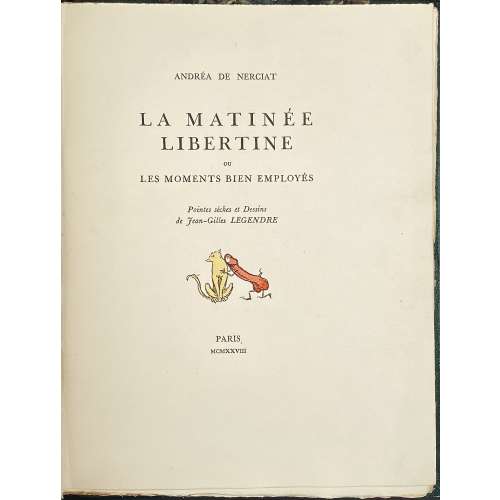 Front wrapper: LA MATINÉE | {vignette} | LIBERTINE || Title-page: ANDRÉA DE NERCIAT | LA MATINÉE | LIBERTINE | OU LES MOMENTS BIEN EMPLOYÉS | Pointes sèches et Dessins | de Jean-Gilles LEGENDRE | {fleuron in colour} | PARIS | MCMXXVIII || Description: Owner’s ¾ green morocco over marbled boards, raised bands, gilt lettering to spine, 24.3 x 19 cm overall, 23 x 17.5 cm leaves, green marbled endpapers, printed on BFK Rives watermarked wove paper. Collation: Orig. wrapper, [1-4] 2 blank leaves, [5-6] h.t. / limitation, [7-8] t.p. / blank, [9-10] avant-propos / blank, [11] 12-118, 4 blank leaves, orig. spine, orig. back wrapper, 9 hand-coloured dry-point plates with tissue guards, incl. engraved title/frontispiece, in-text colour illustrations (chromoxylography?). Limitation: A print run of 196 copies, № 1 on Vieux Japon, №№ 2-9 on Japon Impérial, №№ 10-21 on Hollande Van Gelder, and №№ 22-196 on Velin à la forme; this copy marked "H.C." (Horse Commerce") – not for sale (NFS), printed over the print run and reserved for the artist, other contributors, and their friends. Catalogue raisonné: Dutel (1920-1970): № 1939, p. 255: attributes publisher, and in-text illustration count; does not provide for H.C. copies in limitation. Contributors: André-Robert Andréa de Nerciat (French, 1739 – 1800) – author. Gaston Trilleau [pseud. Jean-Gilles Legendre] (French, 1874 – 1945) – illustrator. Maurice Henri Hector Duflou (French, 1885 – 1951) – publisher/printer.
Front wrapper: LA MATINÉE | {vignette} | LIBERTINE || Title-page: ANDRÉA DE NERCIAT | LA MATINÉE | LIBERTINE | OU LES MOMENTS BIEN EMPLOYÉS | Pointes sèches et Dessins | de Jean-Gilles LEGENDRE | {fleuron in colour} | PARIS | MCMXXVIII || Description: Owner’s ¾ green morocco over marbled boards, raised bands, gilt lettering to spine, 24.3 x 19 cm overall, 23 x 17.5 cm leaves, green marbled endpapers, printed on BFK Rives watermarked wove paper. Collation: Orig. wrapper, [1-4] 2 blank leaves, [5-6] h.t. / limitation, [7-8] t.p. / blank, [9-10] avant-propos / blank, [11] 12-118, 4 blank leaves, orig. spine, orig. back wrapper, 9 hand-coloured dry-point plates with tissue guards, incl. engraved title/frontispiece, in-text colour illustrations (chromoxylography?). Limitation: A print run of 196 copies, № 1 on Vieux Japon, №№ 2-9 on Japon Impérial, №№ 10-21 on Hollande Van Gelder, and №№ 22-196 on Velin à la forme; this copy marked "H.C." (Horse Commerce") – not for sale (NFS), printed over the print run and reserved for the artist, other contributors, and their friends. Catalogue raisonné: Dutel (1920-1970): № 1939, p. 255: attributes publisher, and in-text illustration count; does not provide for H.C. copies in limitation. Contributors: André-Robert Andréa de Nerciat (French, 1739 – 1800) – author. Gaston Trilleau [pseud. Jean-Gilles Legendre] (French, 1874 – 1945) – illustrator. Maurice Henri Hector Duflou (French, 1885 – 1951) – publisher/printer. -
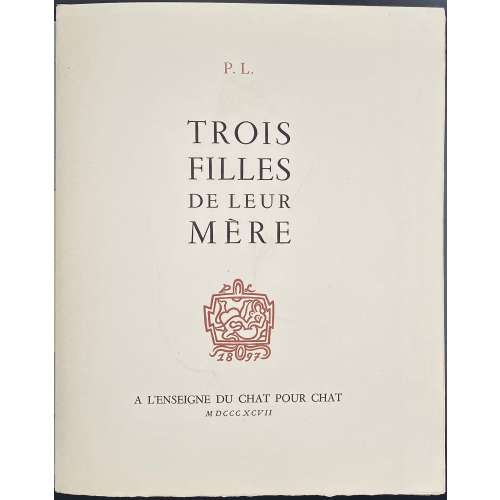 Description: Softcover, original blue-grey wrappers, maroon fleuron to front wrapper « P.L. {copulating couple} 1897. », 28.5 x 23 cm, in a grey double slipcase. Pp.: [1-10] 11-192 [2] [6 blanks], total 200 pages, 50 folio leaves folded in half collated in 4to, unbound, plus 16 coloured lithographs by Jean Berque; all printed on wove paper watermarked “LANA”. This is № 207 of an undisclosed number of copies. Edition enriched with a suite of 12 hand-coloured etchings after Éduard Chimot for publication in the late 1940s (Dutel 2524) on BFK Rives paper. Title-page (maroon and black): P. L. | TROIS | FILLES | DE LEUR | MÈRE | {fleuron} | A L'ENSEIGNE DU CHAT POUR CHAT | M DCCC XCVII || Catalogue raisonné: Dutel 2523, Pia 1340. Contributors: Pierre Louÿs (French, 1870 – 1925) – author. Jean Berque (French, 1896 – 1954) – artist. Édouard Chimot (French, 1880 – 1959) – artist.
Description: Softcover, original blue-grey wrappers, maroon fleuron to front wrapper « P.L. {copulating couple} 1897. », 28.5 x 23 cm, in a grey double slipcase. Pp.: [1-10] 11-192 [2] [6 blanks], total 200 pages, 50 folio leaves folded in half collated in 4to, unbound, plus 16 coloured lithographs by Jean Berque; all printed on wove paper watermarked “LANA”. This is № 207 of an undisclosed number of copies. Edition enriched with a suite of 12 hand-coloured etchings after Éduard Chimot for publication in the late 1940s (Dutel 2524) on BFK Rives paper. Title-page (maroon and black): P. L. | TROIS | FILLES | DE LEUR | MÈRE | {fleuron} | A L'ENSEIGNE DU CHAT POUR CHAT | M DCCC XCVII || Catalogue raisonné: Dutel 2523, Pia 1340. Contributors: Pierre Louÿs (French, 1870 – 1925) – author. Jean Berque (French, 1896 – 1954) – artist. Édouard Chimot (French, 1880 – 1959) – artist. -
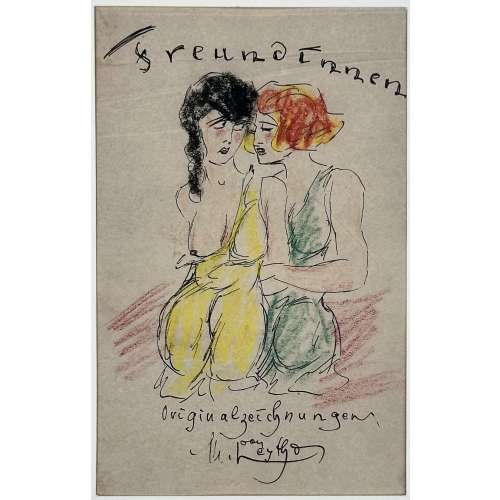 Seven pen and ink and colour crayon drawings on thin wove paper approx. 140 x 100 mm, each attached to a sheet 310 x 240 mm and mounted in a passepartout, placed in an aubergine cardboard folder 310 x 250 mm with a tan vellum spine and paper flaps inside; olive label with double border and gilt lettering to front cover "Dessins" [Drawings]. The first sheet is a title-page lettered in manuscript: Freundinnen | {vignette} | Originalzeichnungen | M. Leytho || [Girlfriends. Original drawings]. Information about the artist at www.honesterotica.com: "Mitja Leytho, almost certainly a pseudonym, is yet another mediocre yet fascinating amateur artist from the Germany of the 1920s about whom we know absolutely nothing beyond the four portfolios which bear the ‘Leytho’ signature". We shall notice that this set of drawings was produced by a talented professional, not an amateur.
Seven pen and ink and colour crayon drawings on thin wove paper approx. 140 x 100 mm, each attached to a sheet 310 x 240 mm and mounted in a passepartout, placed in an aubergine cardboard folder 310 x 250 mm with a tan vellum spine and paper flaps inside; olive label with double border and gilt lettering to front cover "Dessins" [Drawings]. The first sheet is a title-page lettered in manuscript: Freundinnen | {vignette} | Originalzeichnungen | M. Leytho || [Girlfriends. Original drawings]. Information about the artist at www.honesterotica.com: "Mitja Leytho, almost certainly a pseudonym, is yet another mediocre yet fascinating amateur artist from the Germany of the 1920s about whom we know absolutely nothing beyond the four portfolios which bear the ‘Leytho’ signature". We shall notice that this set of drawings was produced by a talented professional, not an amateur. -
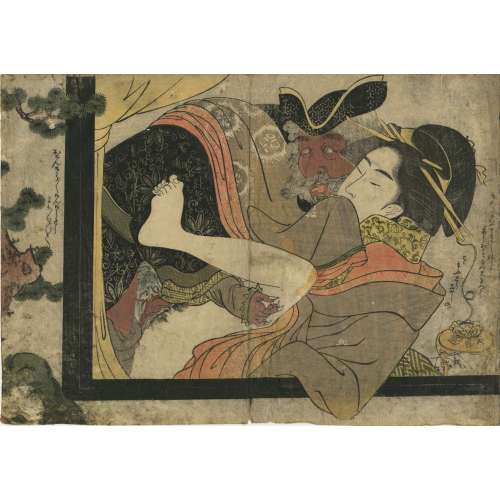 Woodblock print album of thirteen prints, ōban, nishiki-e. Artist: Chōkyōsai Eiri [鳥橋斎 栄里] (Japanese, fl. c. 1789 ~ 1801 ). Models of calligraphy (Fumi no kiyogaki), New Year 1801. This title is taken from Chris Uhlenbeck's Japanese Erotic Fantasies Sexual Imagery of the Edo Period. — Hotei Publishing, 2005, ISBN 90-74822-66-5):. A detailed description of the album can be found at The Complete Ukiyo-e Shunga №9 Eiri, 1996, ISBN 4-309-91019. Most of the edition is in Japanese, though Richard Lane writes a section in English: Eiri: Love-letters, Love Consummated: Fumi-no-kiyogaki. The article starts with the following statement: "Why all the fuss about Sharaku? Because he is so "mysterious"? No, not at all: because he is such a good artist. But Sharaku is not the only great yet enigmatic ukiyo-e artist and I propose to resurrect here one of his important contemporaries who has been all too long neglected: Chōkyōsai Eiri. As with many of the notable ukiyo-e masters, nothing is known of Eiri's biography. All we can say is what we learn from his extant prints and paintings: that he flourished during the second half of the Kansei Period [1789-1801]; and that he was a direct pupil of the great Eishi - who, being of eminent samurai stock, may well have attracted pupils of similar background." Another citation from Japanese Erotic Fantasies: "This album is one of the boldest sets of ōban-size shunga known, The first edition contains thirteen instead of the customary twelve designs". Here I present all thirteen prints, though the edition I bought in Kyoto in 2014 contained only twelve. The thirteenth print was purchased later in the United States (sheet №12).
Woodblock print album of thirteen prints, ōban, nishiki-e. Artist: Chōkyōsai Eiri [鳥橋斎 栄里] (Japanese, fl. c. 1789 ~ 1801 ). Models of calligraphy (Fumi no kiyogaki), New Year 1801. This title is taken from Chris Uhlenbeck's Japanese Erotic Fantasies Sexual Imagery of the Edo Period. — Hotei Publishing, 2005, ISBN 90-74822-66-5):. A detailed description of the album can be found at The Complete Ukiyo-e Shunga №9 Eiri, 1996, ISBN 4-309-91019. Most of the edition is in Japanese, though Richard Lane writes a section in English: Eiri: Love-letters, Love Consummated: Fumi-no-kiyogaki. The article starts with the following statement: "Why all the fuss about Sharaku? Because he is so "mysterious"? No, not at all: because he is such a good artist. But Sharaku is not the only great yet enigmatic ukiyo-e artist and I propose to resurrect here one of his important contemporaries who has been all too long neglected: Chōkyōsai Eiri. As with many of the notable ukiyo-e masters, nothing is known of Eiri's biography. All we can say is what we learn from his extant prints and paintings: that he flourished during the second half of the Kansei Period [1789-1801]; and that he was a direct pupil of the great Eishi - who, being of eminent samurai stock, may well have attracted pupils of similar background." Another citation from Japanese Erotic Fantasies: "This album is one of the boldest sets of ōban-size shunga known, The first edition contains thirteen instead of the customary twelve designs". Here I present all thirteen prints, though the edition I bought in Kyoto in 2014 contained only twelve. The thirteenth print was purchased later in the United States (sheet №12). №1: "...one of the most exotic scenes in all shunga. A Dutch kapitan is discovered coupling with a lovely Japanese courtesan, beside a large window opening upon a garden...".
№1: "...one of the most exotic scenes in all shunga. A Dutch kapitan is discovered coupling with a lovely Japanese courtesan, beside a large window opening upon a garden...".

 №2: "...a fair young harlot is seen masturbating with a grinding-pestle - a man watches intently from under bedding." [I have two specimens of this design; the one from album is more soiled but less faded].
№2: "...a fair young harlot is seen masturbating with a grinding-pestle - a man watches intently from under bedding." [I have two specimens of this design; the one from album is more soiled but less faded].
 №3: "...the artist has effectively contrasted the lovers by depicting the man's face as seen through the geisha's gauze skirt. [...] we are impressed more by strikingly elegant composition, the dramatic coloring, rather than feeling any great urge to participate in the energetic proceedings..."
№3: "...the artist has effectively contrasted the lovers by depicting the man's face as seen through the geisha's gauze skirt. [...] we are impressed more by strikingly elegant composition, the dramatic coloring, rather than feeling any great urge to participate in the energetic proceedings..."
 №4: "This scene is a most straightforward one, featuring the standard Missionary Position [capitalization by R. Lane].; but withal, the contrast of the young and naked, secret lover and the richly-clothed courtesan amid luxurious bedding..."
№4: "This scene is a most straightforward one, featuring the standard Missionary Position [capitalization by R. Lane].; but withal, the contrast of the young and naked, secret lover and the richly-clothed courtesan amid luxurious bedding..."
 №5: "In a striking lesbian scene (which has no equivalent in Utamaro, and is, incidentally, often omitted in later editions of this album), the girl at left prepares to receive the harikata (dildo) worn by the older girl at right (who holds a seashell containing lubricant)."
№5: "In a striking lesbian scene (which has no equivalent in Utamaro, and is, incidentally, often omitted in later editions of this album), the girl at left prepares to receive the harikata (dildo) worn by the older girl at right (who holds a seashell containing lubricant)."
 №6: "In the first appearance of a matronly heroine in this series, we find a widow - with shaven eyebrows and clipped hair - sporting with a handsome yound shop-clerk, mounting him with all her might."
№6: "In the first appearance of a matronly heroine in this series, we find a widow - with shaven eyebrows and clipped hair - sporting with a handsome yound shop-clerk, mounting him with all her might."

 №7: "... lady of samurai court: here, shown taking advantage of an official outing to temple and theatre, to rendezvous with a secret lover on a teahouse balcony." R. Lane considers this design the least successful in the series, especially in comparison with the same theme by Utamaro: "Utamaro female is almost ferocious in her lust for sexual gratification", which does not sound true to me. See Utamaro's sheet №5 from the album Utamakura (歌まくら, Poem of the Pillow) [courtesy The British Museum without permission]:
№7: "... lady of samurai court: here, shown taking advantage of an official outing to temple and theatre, to rendezvous with a secret lover on a teahouse balcony." R. Lane considers this design the least successful in the series, especially in comparison with the same theme by Utamaro: "Utamaro female is almost ferocious in her lust for sexual gratification", which does not sound true to me. See Utamaro's sheet №5 from the album Utamakura (歌まくら, Poem of the Pillow) [courtesy The British Museum without permission]:
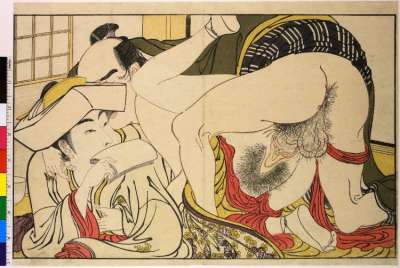 Then, as Richard Lane states, "we are flung suddenly to the bottom rung of Edo society":
Then, as Richard Lane states, "we are flung suddenly to the bottom rung of Edo society":
 №8: "Here we find a fair yotaka ('night-hawk', e.i. streetwalker) accommodating a lusty client in a lumberyard by the bank of the Sumida River".
№8: "Here we find a fair yotaka ('night-hawk', e.i. streetwalker) accommodating a lusty client in a lumberyard by the bank of the Sumida River".
 №9: '... a slightly plump harlot of the lower class receives a night visit from her lover, whose naked form she tries to cover with a cloak."
№9: '... a slightly plump harlot of the lower class receives a night visit from her lover, whose naked form she tries to cover with a cloak."
 №10: "...likely maidservant and lackey - are depicted in bath-room, their passions are all too obviously fired by steaming water."
№10: "...likely maidservant and lackey - are depicted in bath-room, their passions are all too obviously fired by steaming water."
 №11: "...this scene of courtesan and secret lover ranks high not only in Eiri's œuvre but also in the annals of the ukiyo-e genre itself. Both design and colouring are impeccable and, for this period, there is nothing even in the work of great Utamaro that really surpasses it." Again, a doubtful statement, however, this is Utamaro's design for the reader to judge:
№11: "...this scene of courtesan and secret lover ranks high not only in Eiri's œuvre but also in the annals of the ukiyo-e genre itself. Both design and colouring are impeccable and, for this period, there is nothing even in the work of great Utamaro that really surpasses it." Again, a doubtful statement, however, this is Utamaro's design for the reader to judge:
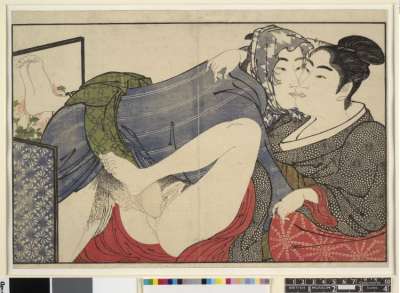 The last design in my album is this:
The last design in my album is this:
 #13: In most reference books it goes under number 13, and we will assign this number to the sheet. "The final scene of the album features naked participants, probably samurai man and wife. The print is rather subdued in tone and colour, if not in the degree of the passion displayed..."
An additional sheet, acquired separately from a reputable dealer in New York, is usually listed as №12:
#13: In most reference books it goes under number 13, and we will assign this number to the sheet. "The final scene of the album features naked participants, probably samurai man and wife. The print is rather subdued in tone and colour, if not in the degree of the passion displayed..."
An additional sheet, acquired separately from a reputable dealer in New York, is usually listed as №12:
 №12: "One might think that Eiri has reached his peak with the preceding plate 11 - and indeed he has, in both esthetic and erotic terms. But the album is not yet finished, and the next scene lends a needed variety to the series, a slightly comic tableau featuring a middle-aged lackey attempting to forcibly seduce a servant girl of the same domicile". Utamaro's design, that inspired Eiri is here:
№12: "One might think that Eiri has reached his peak with the preceding plate 11 - and indeed he has, in both esthetic and erotic terms. But the album is not yet finished, and the next scene lends a needed variety to the series, a slightly comic tableau featuring a middle-aged lackey attempting to forcibly seduce a servant girl of the same domicile". Utamaro's design, that inspired Eiri is here:
 All descriptions are taken from Richard Lane's article at The Complete Ukiyo-e Shunga №9 Eiri, 1996. He concluded: "...Eiri's erotic series represents a major contribution to shunga art towards the close of ukiyo-e "Golden Age". In part inspired by Utamaro's classic album, this series withal constitutes a unified and original achievement, providing a cumulative effect of gracefully elegant yet glowing eroticism, which remains in the mind's eye long after the pictures themselves are far away."
I only would like to mention here that in several reference sources this album goes under name of Eisho; unfortunately, this mistake is reproduced at www.ukiyo-e.org, which miraculously shows exactly my print, but under the wrong name of the artist. The same mistake can be found at Shunga. The art of love in Japan. Tom and Mary Anne Evans. Paddington Press Ltd., 1975. ISBN 0-8467-0066-2; plates 6.74-6.77: Chōkyōsai Eishō, c. 1800. Even the British Museum edition of 2010 gives the same erroneous attribution: Chōkyōsai Eishō (1793-1801); they provide the following translation of title: "Clean Draft of a Letter" [see: Shunga. Erotic art in Japan. Rosina Buckland. The British Museum Press, 2010; pp. 110-112]. To the honour of the British Museum, I must admit that they have corrected themselves in Shunga. Sex and pleasure in Japanese art. Edited by Timothy Clark, et al. Hotei Publishing, 2013. Now, they say Chōkyōsai Eiri (worked c. 1790s-1801); they also provide a new title: "Neat Version of the Love Letter, or Pure Drawings of Female Beauty". I have already mentioned Richard Lane's version of title: "Love-letters, Love Consummated", and Chris Uhlenbeck's "Models of calligraphy". In poorly designed and printed Shunga. Erotic figures in Japanese art. Presented by Gabriele Mandel. Translated by Alison L'Eplattenier. Crescent Books, New York, 1983, the artist is named Shokyosai Eisho (beginning of the 19th century); title provided: "Models of Calligraphy". Correct attribution to Chōkyōsai Eiri also can be found at Poem of the pillow and other stories by Utamaro, Hokusai, Kuniyoshi and other artists of the floating world. Gian Carlo Calza in collaboration with Stefania Piotti. Phaidon Press, 2010; though the title is translated as "Clean Copy of Female Beauty".
All descriptions are taken from Richard Lane's article at The Complete Ukiyo-e Shunga №9 Eiri, 1996. He concluded: "...Eiri's erotic series represents a major contribution to shunga art towards the close of ukiyo-e "Golden Age". In part inspired by Utamaro's classic album, this series withal constitutes a unified and original achievement, providing a cumulative effect of gracefully elegant yet glowing eroticism, which remains in the mind's eye long after the pictures themselves are far away."
I only would like to mention here that in several reference sources this album goes under name of Eisho; unfortunately, this mistake is reproduced at www.ukiyo-e.org, which miraculously shows exactly my print, but under the wrong name of the artist. The same mistake can be found at Shunga. The art of love in Japan. Tom and Mary Anne Evans. Paddington Press Ltd., 1975. ISBN 0-8467-0066-2; plates 6.74-6.77: Chōkyōsai Eishō, c. 1800. Even the British Museum edition of 2010 gives the same erroneous attribution: Chōkyōsai Eishō (1793-1801); they provide the following translation of title: "Clean Draft of a Letter" [see: Shunga. Erotic art in Japan. Rosina Buckland. The British Museum Press, 2010; pp. 110-112]. To the honour of the British Museum, I must admit that they have corrected themselves in Shunga. Sex and pleasure in Japanese art. Edited by Timothy Clark, et al. Hotei Publishing, 2013. Now, they say Chōkyōsai Eiri (worked c. 1790s-1801); they also provide a new title: "Neat Version of the Love Letter, or Pure Drawings of Female Beauty". I have already mentioned Richard Lane's version of title: "Love-letters, Love Consummated", and Chris Uhlenbeck's "Models of calligraphy". In poorly designed and printed Shunga. Erotic figures in Japanese art. Presented by Gabriele Mandel. Translated by Alison L'Eplattenier. Crescent Books, New York, 1983, the artist is named Shokyosai Eisho (beginning of the 19th century); title provided: "Models of Calligraphy". Correct attribution to Chōkyōsai Eiri also can be found at Poem of the pillow and other stories by Utamaro, Hokusai, Kuniyoshi and other artists of the floating world. Gian Carlo Calza in collaboration with Stefania Piotti. Phaidon Press, 2010; though the title is translated as "Clean Copy of Female Beauty".
-
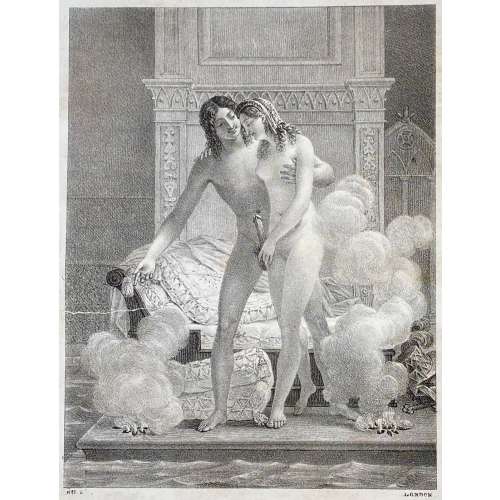 Description: Two volumes in one, collated 4to, 32.5 x 25.3 cm, bound in 19th-century long-grain green shagreen, flapped portfolio with a bronze lock clasp, gilt centrepiece fleuron, gilt- and blind-tooled boards and spine, spine with false raised bands, gilt-lettered "ESSAI | SUR LA MORALE"; text printed on bluish laid paper, blue marbled pastedowns; h.t. and t.p. in both volumes present. Restoration and conservation by Zukor art conservation in September 2022. Title-page: LA PUCELLE | D'ORLÉANS, | POËME EN VINGT-UN CHANTS. | Par VOLTAIRE | Édition ornée de Figures gravées par les meilleurs | Artistes de Paris. | — | TOME PREMIER (TOME SECOND). | — | A PARIS, | DE L’IMPRIMERIE DE DIDOT LE JEUNE. | L’AN TROISIÈME. || Imprint: A PARIS, | Chez les Frères Jacquenod, rue de Condé, no. 15. | A LYON, chez les mêmes. || Collation: Vol. 1: A-Z4, 2A-2H4 2I2; total 126 leaves; Vol. 2: A-Z4, 2A4 2B2, 2C-D4, 2E3 2F-2N4; total 141 leaves; first and last blank, plus 21 plates extraneous to collation, 8 in the 1st volume (incl. frontispiece) and 13 in the 2nd. Pagination: Vol. 1: [1-5] 6-251 [252], total 252 pages, ils; Note: leave 2A1 has a loss of 1/6 of the top, leave 2A2 torn out completely; Vol. 2: [1-5] 6-212, 2[211] 2212 [213] 214-279 [280], duplication of numbers 211 and 212 => total 282 pages, ils. The total number of pages in the volume is 534; one page torn out (187/8 in Vol. 1) Catalogue raisonné: Nordmann (2): № 562, p. 278; Cohen-deRicci: 1034. According to Nordmann (Christie’s), it was an edition illustrated with 21 plates after Lebarbier, Marillier, Monnet and Monsiau produced by various engravers; in the 1840s those plates were replaced with 24 lithographs by Achille Devéria, who signed them “LONDON”. In Nordmann’s copy, there is also a set of hand-coloured lithographs. There are only 21 plates in our copy, lacking three as per the source. Contributors : François Marie Arouet de Voltaire (French, 1694 – 1778) – author. Achille Devéria (French, 1800 – 1857) – artist. Pierre-Nicolas-Firmin Didot [Didot le Jeune] (French, 1769 – 1836) – publisher.
Description: Two volumes in one, collated 4to, 32.5 x 25.3 cm, bound in 19th-century long-grain green shagreen, flapped portfolio with a bronze lock clasp, gilt centrepiece fleuron, gilt- and blind-tooled boards and spine, spine with false raised bands, gilt-lettered "ESSAI | SUR LA MORALE"; text printed on bluish laid paper, blue marbled pastedowns; h.t. and t.p. in both volumes present. Restoration and conservation by Zukor art conservation in September 2022. Title-page: LA PUCELLE | D'ORLÉANS, | POËME EN VINGT-UN CHANTS. | Par VOLTAIRE | Édition ornée de Figures gravées par les meilleurs | Artistes de Paris. | — | TOME PREMIER (TOME SECOND). | — | A PARIS, | DE L’IMPRIMERIE DE DIDOT LE JEUNE. | L’AN TROISIÈME. || Imprint: A PARIS, | Chez les Frères Jacquenod, rue de Condé, no. 15. | A LYON, chez les mêmes. || Collation: Vol. 1: A-Z4, 2A-2H4 2I2; total 126 leaves; Vol. 2: A-Z4, 2A4 2B2, 2C-D4, 2E3 2F-2N4; total 141 leaves; first and last blank, plus 21 plates extraneous to collation, 8 in the 1st volume (incl. frontispiece) and 13 in the 2nd. Pagination: Vol. 1: [1-5] 6-251 [252], total 252 pages, ils; Note: leave 2A1 has a loss of 1/6 of the top, leave 2A2 torn out completely; Vol. 2: [1-5] 6-212, 2[211] 2212 [213] 214-279 [280], duplication of numbers 211 and 212 => total 282 pages, ils. The total number of pages in the volume is 534; one page torn out (187/8 in Vol. 1) Catalogue raisonné: Nordmann (2): № 562, p. 278; Cohen-deRicci: 1034. According to Nordmann (Christie’s), it was an edition illustrated with 21 plates after Lebarbier, Marillier, Monnet and Monsiau produced by various engravers; in the 1840s those plates were replaced with 24 lithographs by Achille Devéria, who signed them “LONDON”. In Nordmann’s copy, there is also a set of hand-coloured lithographs. There are only 21 plates in our copy, lacking three as per the source. Contributors : François Marie Arouet de Voltaire (French, 1694 – 1778) – author. Achille Devéria (French, 1800 – 1857) – artist. Pierre-Nicolas-Firmin Didot [Didot le Jeune] (French, 1769 – 1836) – publisher. -
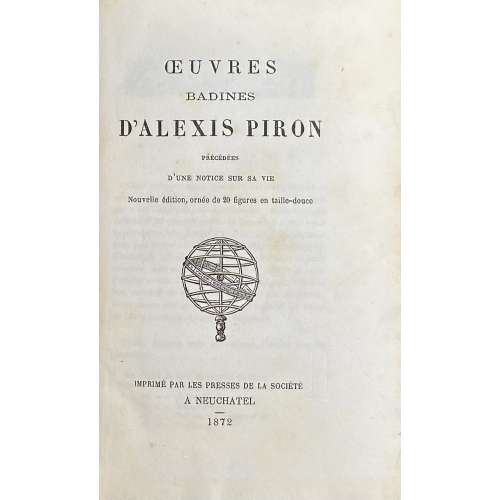 Single volume, 17.1 x 11.2 cm, quarter black sheepskin over faux chagrin, gilt lettering to spine, marbled endpapers, bottom and outer margin untrimmed, pp.: [i-v] vi- xxxvi, [1] 2-218 [2], collated 4to: π2, a-d4, 1-274 282, total 256 pages or 128 leaves, plus 20 engraved plates by Paul Sellier, including frontispiece portrait of Alexis Piron after bust by Caffieri. Vol. 8 of Bibliothèque Libre, Œuvres badines de Piron, printed on February 15, 1872. Text printed on dense wove paper watermarked P or M, plates printed on India wove paper. A reprint of an edition published in 1796 plus illustrations. Title-page: ŒUVRES | BADINES | D’ALEXIS PIRON | PRÉCÉDÉES | D’UNE NOTICE SUR SA VIE | Nouvelle édition, ornée de 20 figures en taille-douce | {vignette} | IMPRIMÉ PAR LES PRESSES DE LA SOCIÉTÉ | A NEUCHATEL | – | 1872 || Limitation: 100 numbered copies, of which this is № 75. Catalogue raisonné: Dutel I: A-788; Pia: 953-6; Kearney 377 (Patrick J. Kearney. A Catalogue of the publications of Jules Gay, Jean-Jules Gay & Gay et Doucé, revised & expanded. — Santa Rosa, CA Scissors & Paste Bibliographies, 2019) Catalogue Poulet-Malassis & ses amis description: № 81. Alexis PIRON. Œuvres badines précédées d’une notice sur sa vie. Nouvelle édition ornée de 20 figures en taille-douce. [ Jules Gay] Imprimé par les presses de la société, à Neufchatel, 1872. In-8, xxxvi, 218 pages et un feuillet d’achevé d’imprimer de table, demi-basane noire, dos à faux nerfs, tête et tranches naturelles. Illustré d’un portrait et de 20 figures par Paul Sellier. Tirage limité à 100 ex. numérotés. De la « Bibliothèque libre ou collection choisie d’ouvrages du genre libre, imprimés ou réimprimés par les soins de la Société des Bibliophiles Cosmopolites et pour les membres de cette société, à cent exemplaires numérotés ». Bibliographie : Pia 1030, Enfer 1274, Lem 3-454, Gay 5-339, PC 353, G* 38, Pey 203, Dutel A-788." Contributors: Alexis Piron (French, 1689 – 1773) – author. Paul Sellier (French, 1842 – 19..?) – artist. Jules Léopold Gay (French, 1807 – 1887) – publisher.
Single volume, 17.1 x 11.2 cm, quarter black sheepskin over faux chagrin, gilt lettering to spine, marbled endpapers, bottom and outer margin untrimmed, pp.: [i-v] vi- xxxvi, [1] 2-218 [2], collated 4to: π2, a-d4, 1-274 282, total 256 pages or 128 leaves, plus 20 engraved plates by Paul Sellier, including frontispiece portrait of Alexis Piron after bust by Caffieri. Vol. 8 of Bibliothèque Libre, Œuvres badines de Piron, printed on February 15, 1872. Text printed on dense wove paper watermarked P or M, plates printed on India wove paper. A reprint of an edition published in 1796 plus illustrations. Title-page: ŒUVRES | BADINES | D’ALEXIS PIRON | PRÉCÉDÉES | D’UNE NOTICE SUR SA VIE | Nouvelle édition, ornée de 20 figures en taille-douce | {vignette} | IMPRIMÉ PAR LES PRESSES DE LA SOCIÉTÉ | A NEUCHATEL | – | 1872 || Limitation: 100 numbered copies, of which this is № 75. Catalogue raisonné: Dutel I: A-788; Pia: 953-6; Kearney 377 (Patrick J. Kearney. A Catalogue of the publications of Jules Gay, Jean-Jules Gay & Gay et Doucé, revised & expanded. — Santa Rosa, CA Scissors & Paste Bibliographies, 2019) Catalogue Poulet-Malassis & ses amis description: № 81. Alexis PIRON. Œuvres badines précédées d’une notice sur sa vie. Nouvelle édition ornée de 20 figures en taille-douce. [ Jules Gay] Imprimé par les presses de la société, à Neufchatel, 1872. In-8, xxxvi, 218 pages et un feuillet d’achevé d’imprimer de table, demi-basane noire, dos à faux nerfs, tête et tranches naturelles. Illustré d’un portrait et de 20 figures par Paul Sellier. Tirage limité à 100 ex. numérotés. De la « Bibliothèque libre ou collection choisie d’ouvrages du genre libre, imprimés ou réimprimés par les soins de la Société des Bibliophiles Cosmopolites et pour les membres de cette société, à cent exemplaires numérotés ». Bibliographie : Pia 1030, Enfer 1274, Lem 3-454, Gay 5-339, PC 353, G* 38, Pey 203, Dutel A-788." Contributors: Alexis Piron (French, 1689 – 1773) – author. Paul Sellier (French, 1842 – 19..?) – artist. Jules Léopold Gay (French, 1807 – 1887) – publisher. -
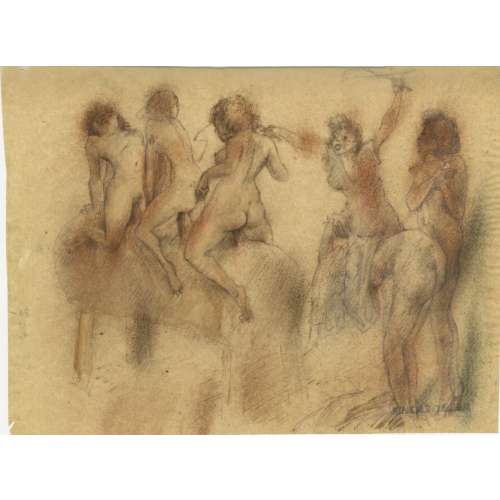 Pencil, pen and ink wash on india paper, 170 x 228 mm, black ink stamp to verso: “Nachlaß O R SCHATS”. Unsigned, attributed to Otto Rudolf Schatz (Austrian, 1900 – 1961).
Pencil, pen and ink wash on india paper, 170 x 228 mm, black ink stamp to verso: “Nachlaß O R SCHATS”. Unsigned, attributed to Otto Rudolf Schatz (Austrian, 1900 – 1961). -
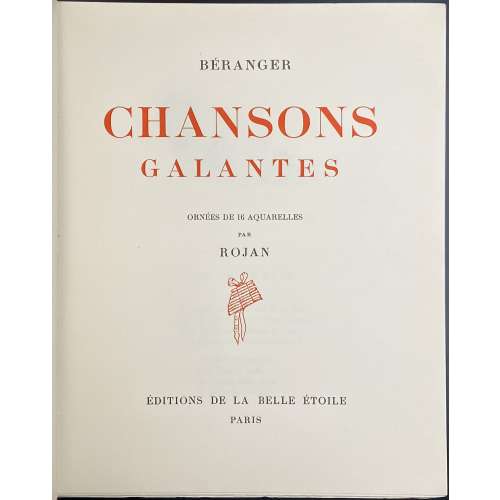 Cover (in red and black): BÉRANGER | CHANSONS | GALANTES | {vignette} || Title page (in red and black): BÉRANGER | CHANSONS | GALANTES | ORNEES DE 16 AQUARELLES | PAR | ROJAN | {vignette} | ÉDITIONS DE LA BELLE ÉTOILE | PARIS || Pagination: [2] – front wrapper, [2] – blank, [1-4] 5-157 [3] [2] blank, [2] – back wrapper; the total number of pages 168 + 16 plates, numerous in-text head- and tailpieces in black. Collation: 4to; [1] 2-214, wrapped leaves included in collation; the total number of leaves 84 + 16 plates. Colour illustrations: 16 full-page colour plates and 4 colour headpieces are produced by the so-called Duval-Beaufumé process (collotype and stencil) of reproductions after Rojan’s watercolours. Tirage: Limited edition of 1500 copies, of which this is № 1434. Binding: Publisher's French flapped cream wrappers with red and black lettering to front wrapper and black lettering to spine, wove paper (vélin Navarre), uncut. Size: 243 x 195 mm. Contributors: Béranger, Pierre-Jean de (French, 1780 – 1857) – author. Rojankovsky, Feodor [Rojan; Рожанковский, Фёдор Степанович] (Russian-American, 1891 – 1970) – artist. NOTE on technique: Micro-photography reveals that this is not a collotype but some sort of photochemical reproduction method, such as a halftone screen. The colour was applied with a stencil, indeed.
Cover (in red and black): BÉRANGER | CHANSONS | GALANTES | {vignette} || Title page (in red and black): BÉRANGER | CHANSONS | GALANTES | ORNEES DE 16 AQUARELLES | PAR | ROJAN | {vignette} | ÉDITIONS DE LA BELLE ÉTOILE | PARIS || Pagination: [2] – front wrapper, [2] – blank, [1-4] 5-157 [3] [2] blank, [2] – back wrapper; the total number of pages 168 + 16 plates, numerous in-text head- and tailpieces in black. Collation: 4to; [1] 2-214, wrapped leaves included in collation; the total number of leaves 84 + 16 plates. Colour illustrations: 16 full-page colour plates and 4 colour headpieces are produced by the so-called Duval-Beaufumé process (collotype and stencil) of reproductions after Rojan’s watercolours. Tirage: Limited edition of 1500 copies, of which this is № 1434. Binding: Publisher's French flapped cream wrappers with red and black lettering to front wrapper and black lettering to spine, wove paper (vélin Navarre), uncut. Size: 243 x 195 mm. Contributors: Béranger, Pierre-Jean de (French, 1780 – 1857) – author. Rojankovsky, Feodor [Rojan; Рожанковский, Фёдор Степанович] (Russian-American, 1891 – 1970) – artist. NOTE on technique: Micro-photography reveals that this is not a collotype but some sort of photochemical reproduction method, such as a halftone screen. The colour was applied with a stencil, indeed.
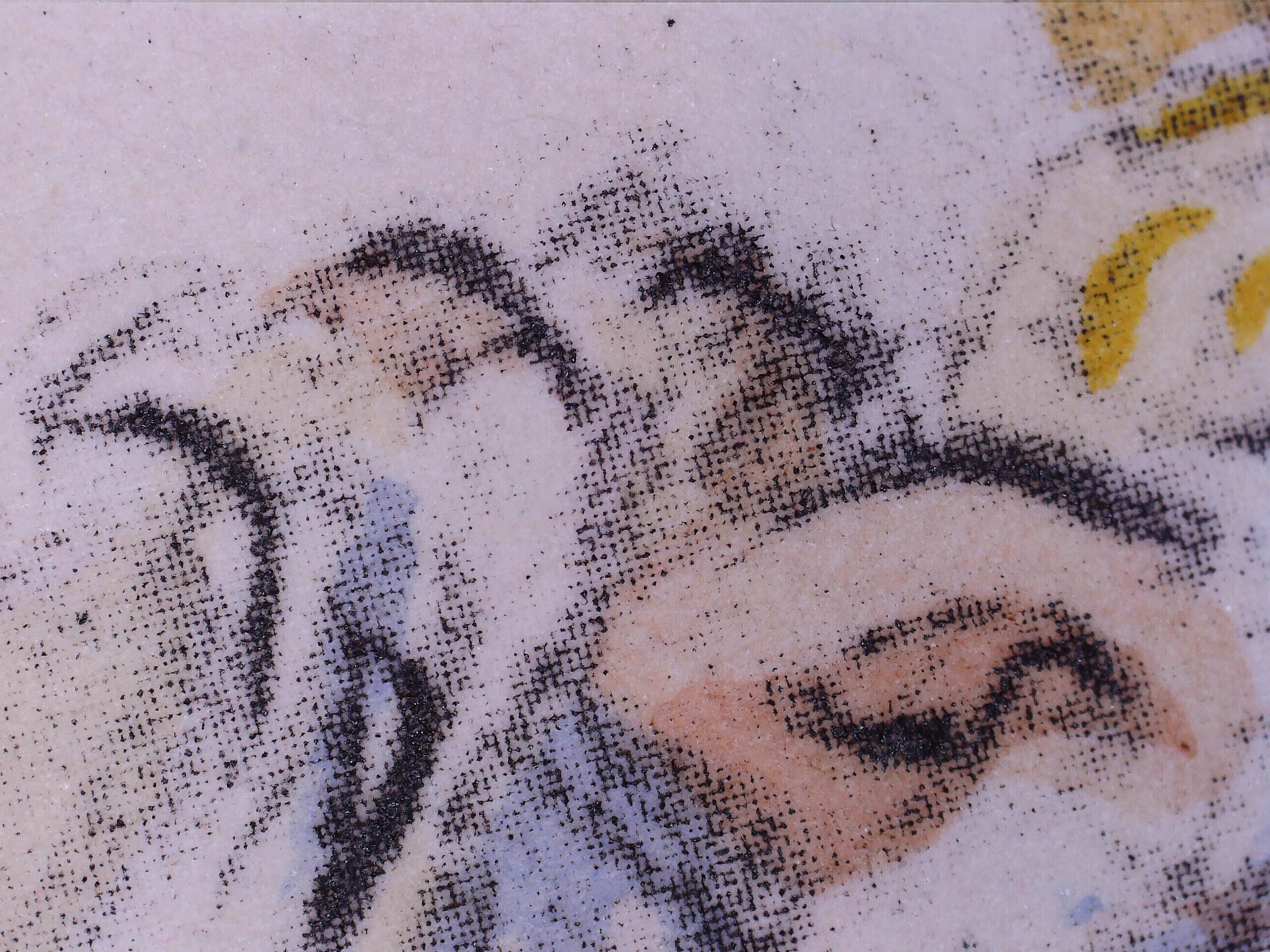
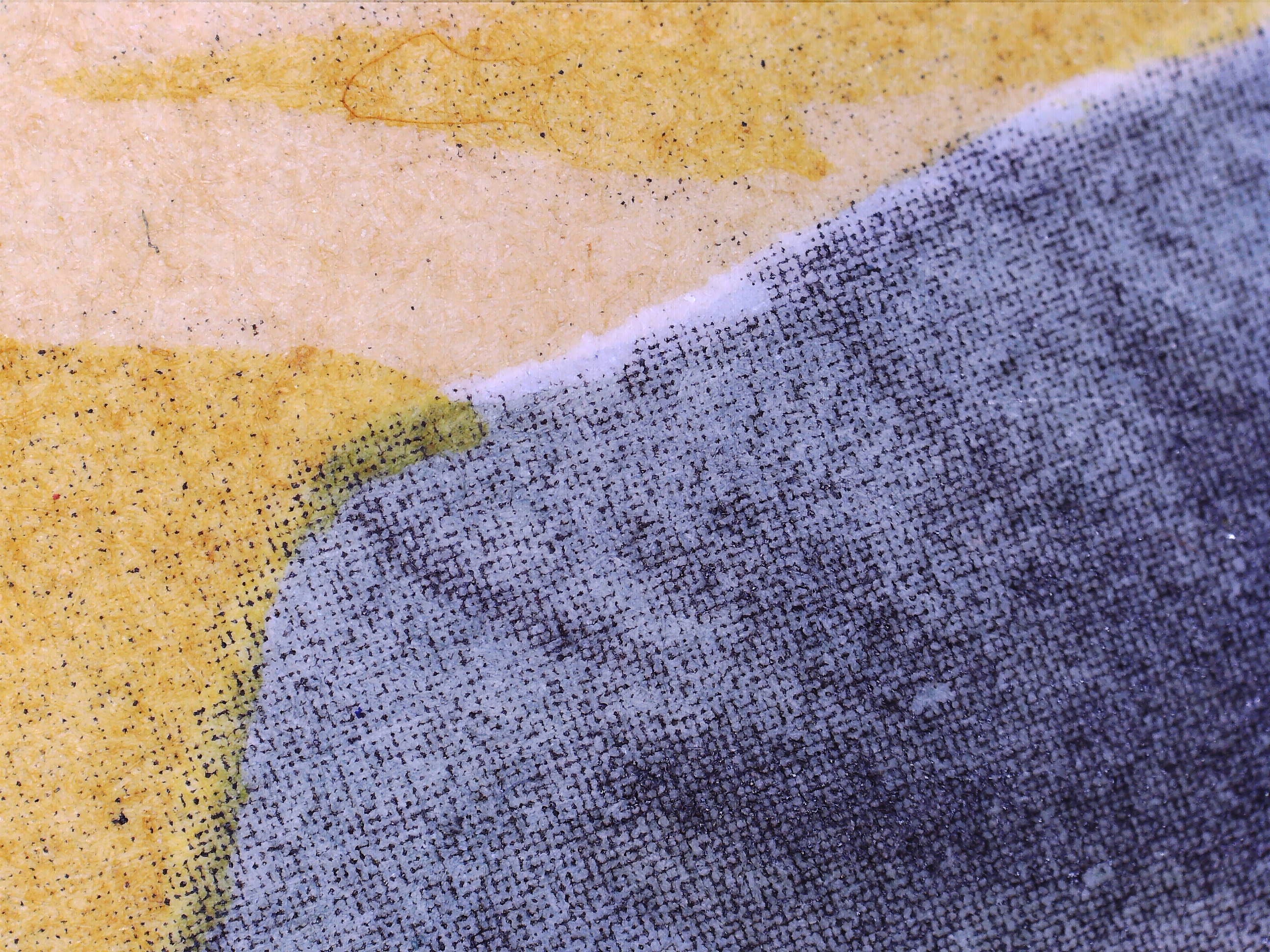
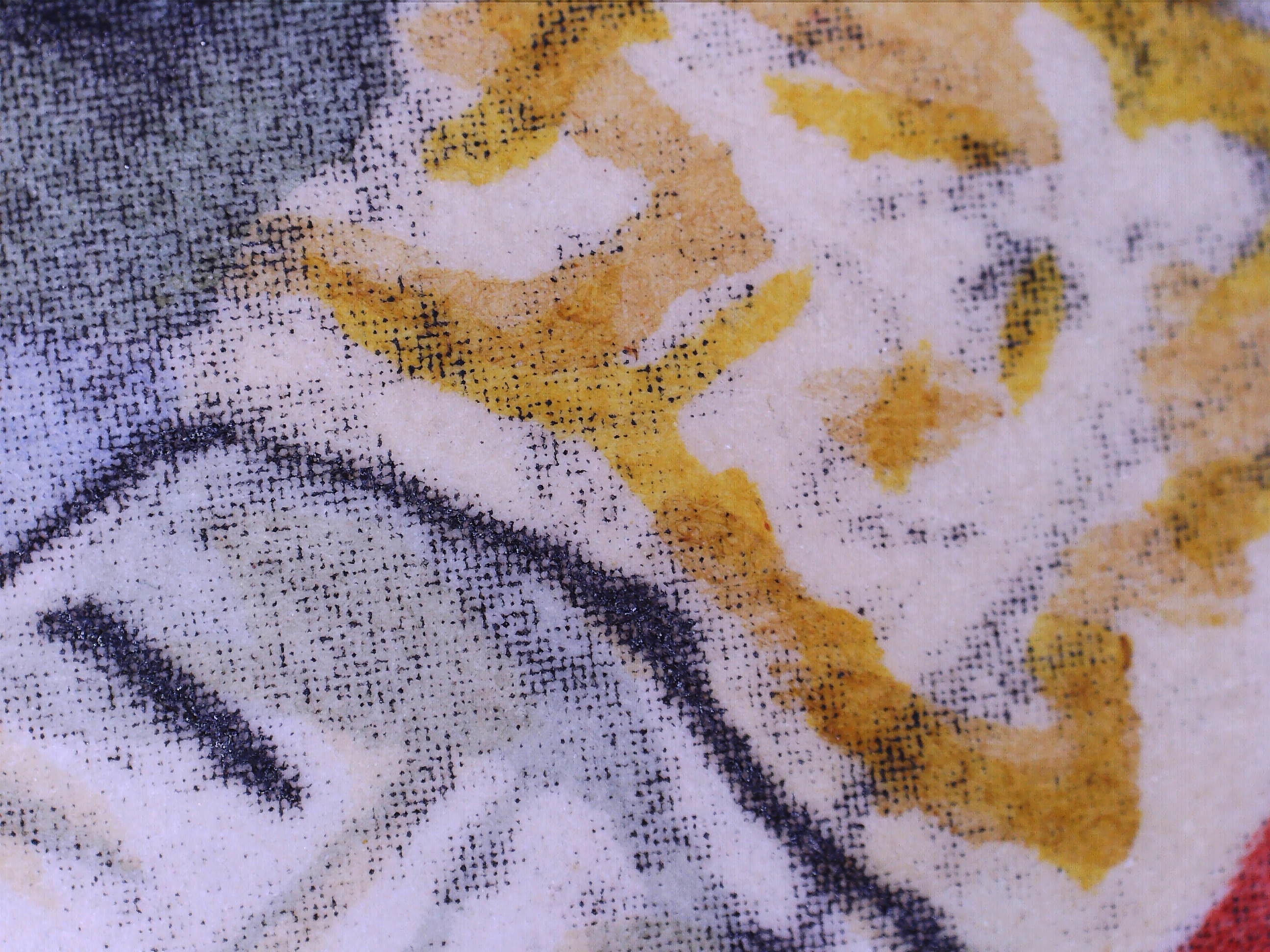
-
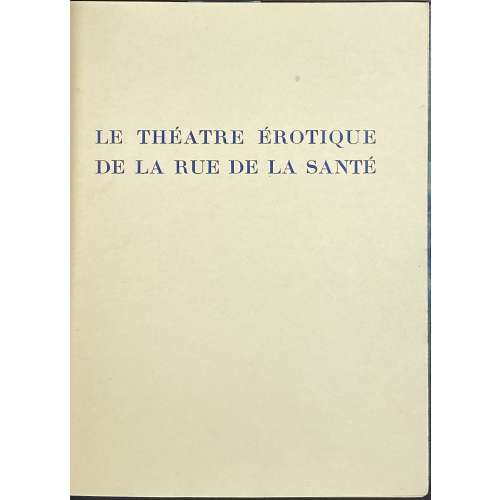 Description: Hardcover, 20.5 x 16 cm, contemporary binding, ¾ calf with raised bands over marbled boards in a marbled slipcase, marbled endpapers, original wrappers preserved, t.e.g., gilt lettering to spine. Content: Scapin Maquereau, drame en un acte par M. Albert Glatigny; La grisette et l’étudiant, pièce en un acte par M. Henry Monnier; Le bout de l’an de la noce, parodie du bout de l’an de l’amour de M. Théodore Barrière par MM. Lemercier de Neuville et J. du Boys; Un caprice par Lemercier de Neuville; Les jeux de l’amour et du bazar, comédie de mœurs en un acte par Lemercier de Neuville. Title-page: LE THÉATRE ÉROTIQUE | DE LA RUE DE LA SANTE | {vignette} | PARIS | — | 1932 || Collation: 2 blanks, original front wrapper with blue lettering «LE THÉATRE ÉROTIQUE | DE LA RUE DE LA SANTE», [1]4 (2 blanks, frontis., h.t. / limitation), [2]4 (t.p., f.t.p., 2 leaves of text), 3-184 (incl. 2 blanks), original back wrapper, original spine, 2 blanks; 5 full-page illustrations within collation, 5 original drawings extraneous to collation. Pagination: [4] [1-8] 9-135 [136] [4], ils. Limitation: 20 copies on Japon and 250 copies on Vélin, this is copy № 12. Edition: 1st edition thus, illustrated with 20 stencil-coloured (au pochoir) photogravures, 5 of them full-page after Feodor Rojankovsky [Rojan], enriched with 5 full-page original crayon drawings by the same artist. Provenance: Stamp with J.-P. Dutel device to 1st blank leaf. Catalogue raisonné: Dutel (1920-1970): 2498, p. 385; Nordmann/Christie’s (2) 515, p. 251 Contributors: Feodor Rojankovsky [Rojan, Фёдор Степанович Рожанковский] (Russian-American, 1891 – 1970) – artist. Joseph Albert Alexandre Glatigny (French, 1839 – 1873) – author. Henry-Bonaventure Monnier (French, 1799 – 1877) – author. Théodore Barrière (French, 1823 – 1877) – author. Louis Lemercier de Neuville [La Haudussière, Louis Lemercier] (French, 1830 – 1918) – author. Jean Charles Duboys [Du Boys] (French, 1836 – 1873) – author. Original crayon drawings by Rojan:
Description: Hardcover, 20.5 x 16 cm, contemporary binding, ¾ calf with raised bands over marbled boards in a marbled slipcase, marbled endpapers, original wrappers preserved, t.e.g., gilt lettering to spine. Content: Scapin Maquereau, drame en un acte par M. Albert Glatigny; La grisette et l’étudiant, pièce en un acte par M. Henry Monnier; Le bout de l’an de la noce, parodie du bout de l’an de l’amour de M. Théodore Barrière par MM. Lemercier de Neuville et J. du Boys; Un caprice par Lemercier de Neuville; Les jeux de l’amour et du bazar, comédie de mœurs en un acte par Lemercier de Neuville. Title-page: LE THÉATRE ÉROTIQUE | DE LA RUE DE LA SANTE | {vignette} | PARIS | — | 1932 || Collation: 2 blanks, original front wrapper with blue lettering «LE THÉATRE ÉROTIQUE | DE LA RUE DE LA SANTE», [1]4 (2 blanks, frontis., h.t. / limitation), [2]4 (t.p., f.t.p., 2 leaves of text), 3-184 (incl. 2 blanks), original back wrapper, original spine, 2 blanks; 5 full-page illustrations within collation, 5 original drawings extraneous to collation. Pagination: [4] [1-8] 9-135 [136] [4], ils. Limitation: 20 copies on Japon and 250 copies on Vélin, this is copy № 12. Edition: 1st edition thus, illustrated with 20 stencil-coloured (au pochoir) photogravures, 5 of them full-page after Feodor Rojankovsky [Rojan], enriched with 5 full-page original crayon drawings by the same artist. Provenance: Stamp with J.-P. Dutel device to 1st blank leaf. Catalogue raisonné: Dutel (1920-1970): 2498, p. 385; Nordmann/Christie’s (2) 515, p. 251 Contributors: Feodor Rojankovsky [Rojan, Фёдор Степанович Рожанковский] (Russian-American, 1891 – 1970) – artist. Joseph Albert Alexandre Glatigny (French, 1839 – 1873) – author. Henry-Bonaventure Monnier (French, 1799 – 1877) – author. Théodore Barrière (French, 1823 – 1877) – author. Louis Lemercier de Neuville [La Haudussière, Louis Lemercier] (French, 1830 – 1918) – author. Jean Charles Duboys [Du Boys] (French, 1836 – 1873) – author. Original crayon drawings by Rojan:
Colour prints after Rojan's drawings: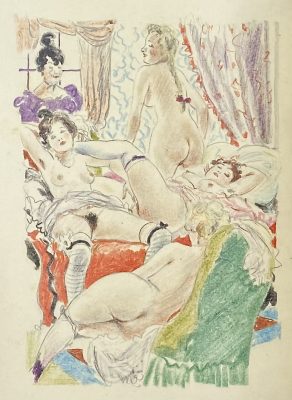
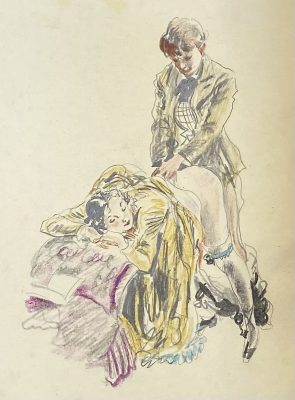
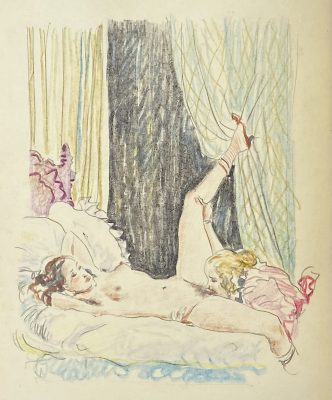
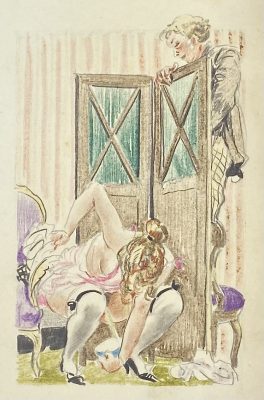
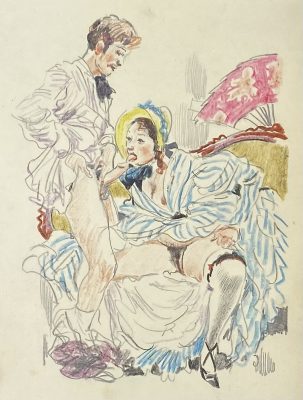
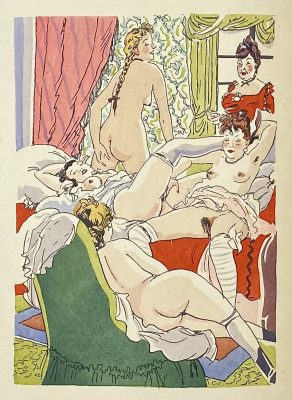
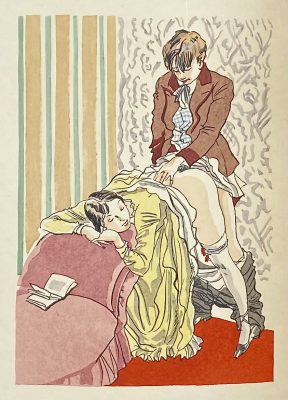
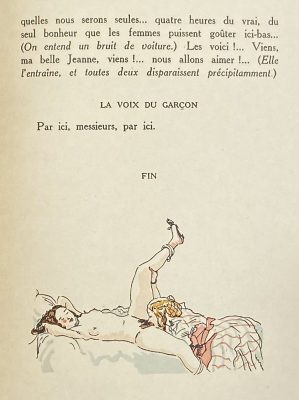
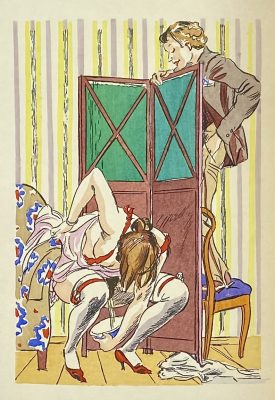
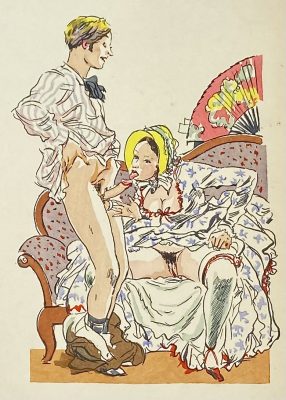
-
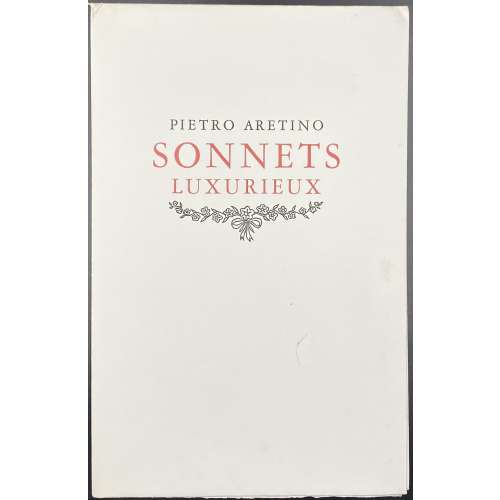 Softcover volume, 25.9 x 16.7 cm, in French flapped wrappers lettered "PIETRO ARETINO | SONNETS | LUXURIEUX | {garland}" unbound, 6 gatherings in 4to (24 leaves, incl. those in wrappers), a few sheets of guard tissue laid in, unpaginated, lower margin untrimmed; in a burgundy double slipcase 26.3 x 17.3 cm. Illustrated with title-page vignette, red initials and tailpieces and 16 half-page engravings by Jean Baptiste Tavy Notton. Text in Italian and French. Title-page (red and black): SONNETS | LUXURIEUX | de | PIETRO ARETINO | dit L'ARÉTIN | avec accompagnement | de gravures au burin | d'après la description des gravures | de GIULIO PIPPI DE GIANNUZZI dit JULES ROMAIN | {vignette} | AUX DÉPENS | DE QUELQUES AMATEURS | 1948 || Clandestine limited edition, print run of 250 copies, of which this is copy № 20, printed on thick wove paper without watermarks. Catalogue raisonné: Dutel III № 2421. Original edition: Sonetti lussuriosi by Pietro Aretino, illustrated by Giulio Romano and engraved by Marcantonio Raimondi, published clandestinely in Venice in c.1527. Contributors: Pietro Aretino (Italian, 1492 – 1556) – author. Jean Baptiste Tavy Notton (French, 1914 – 1971) – artist. Antoine-Isidore Liseux (French, 1835 – 1894) – translator/comments. Giulio Romano [Giulio Pippi, Giulio Giannuzzi] (Italian, c.1499 – 1546) – artist. Marcantonio Raimondi (Italian c. 1470/82 – c. 1534) – engraver.
Softcover volume, 25.9 x 16.7 cm, in French flapped wrappers lettered "PIETRO ARETINO | SONNETS | LUXURIEUX | {garland}" unbound, 6 gatherings in 4to (24 leaves, incl. those in wrappers), a few sheets of guard tissue laid in, unpaginated, lower margin untrimmed; in a burgundy double slipcase 26.3 x 17.3 cm. Illustrated with title-page vignette, red initials and tailpieces and 16 half-page engravings by Jean Baptiste Tavy Notton. Text in Italian and French. Title-page (red and black): SONNETS | LUXURIEUX | de | PIETRO ARETINO | dit L'ARÉTIN | avec accompagnement | de gravures au burin | d'après la description des gravures | de GIULIO PIPPI DE GIANNUZZI dit JULES ROMAIN | {vignette} | AUX DÉPENS | DE QUELQUES AMATEURS | 1948 || Clandestine limited edition, print run of 250 copies, of which this is copy № 20, printed on thick wove paper without watermarks. Catalogue raisonné: Dutel III № 2421. Original edition: Sonetti lussuriosi by Pietro Aretino, illustrated by Giulio Romano and engraved by Marcantonio Raimondi, published clandestinely in Venice in c.1527. Contributors: Pietro Aretino (Italian, 1492 – 1556) – author. Jean Baptiste Tavy Notton (French, 1914 – 1971) – artist. Antoine-Isidore Liseux (French, 1835 – 1894) – translator/comments. Giulio Romano [Giulio Pippi, Giulio Giannuzzi] (Italian, c.1499 – 1546) – artist. Marcantonio Raimondi (Italian c. 1470/82 – c. 1534) – engraver. -
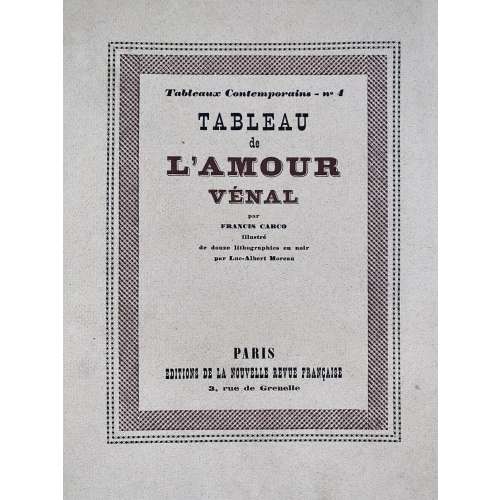 Description: Softcover, French flapped wrappers, lettered front, back (advert.) and spine, collated in-4to, 24.3 x 20.2 cm, printed on thick wove paper Vélin pur fil Lafuma-Navarre, print run limited to 335 copies from which this is copy № 219; outer margin untrimmed, some leaves uncut, glassine DJ. Limitation: 1 copy (A) on Japon Impérial + double suite of plates + suite of original drawings, 4 copies (B-E) on Japon Impérial + double suite of plates, 15 copies on on Japon Impérial + suite of plates on Vieux Japon teinté (F-T), 315 copies on Vélin pur fil Lafuma-Navarre, of which 15 (I-XV) not for sale. Copyright: Libraire Gallimard, 1924. Printed: March 10, 1924 – text by Coulouma (Argenteuil) under direction of H. Barthélemy, lithographs printed by Marchizet (Paris). Front wrapper (in letterpress two-colour border): Tableaux Contemporains – no 4 | . TABLEAU | de | L'AMOUR | VÉNAL | par | FRANCIS CARCO | Illustré | de douze lithographies en noir | par Luc-Albert Moreau | PARIS | ÉDITIONS DE LA NOUVELLE REVUE FRANÇAISE | 3, rue de Grenelle || Title-page: Same, without a frame, in black, L'AMOUR | VÉNAL in brown. Collation: 4to; 14 a4 2-164, total 68 leaves with wrappers included in collation plus 12 plates, incl. frontispiece, extraneous to collation. Pagination: [2 wrapper] [6] [i] ii-vii [viii blank] [9] 10-122 [2 colophon] [2 blank] [2 wrapper]; total 136 pages incl. wrappers, plus ils. Contributors: Francis Carco [François Carcopino-Tusoli] (French, 1886 – 1958) – author. Luc-Albert Moreau (French, 1882 – 1948) – artist. La Nouvelle Revue Française (nrf) (Paris)– publisher. Gaston Gallimard (French, 1881 – 1975) – publisher.
Description: Softcover, French flapped wrappers, lettered front, back (advert.) and spine, collated in-4to, 24.3 x 20.2 cm, printed on thick wove paper Vélin pur fil Lafuma-Navarre, print run limited to 335 copies from which this is copy № 219; outer margin untrimmed, some leaves uncut, glassine DJ. Limitation: 1 copy (A) on Japon Impérial + double suite of plates + suite of original drawings, 4 copies (B-E) on Japon Impérial + double suite of plates, 15 copies on on Japon Impérial + suite of plates on Vieux Japon teinté (F-T), 315 copies on Vélin pur fil Lafuma-Navarre, of which 15 (I-XV) not for sale. Copyright: Libraire Gallimard, 1924. Printed: March 10, 1924 – text by Coulouma (Argenteuil) under direction of H. Barthélemy, lithographs printed by Marchizet (Paris). Front wrapper (in letterpress two-colour border): Tableaux Contemporains – no 4 | . TABLEAU | de | L'AMOUR | VÉNAL | par | FRANCIS CARCO | Illustré | de douze lithographies en noir | par Luc-Albert Moreau | PARIS | ÉDITIONS DE LA NOUVELLE REVUE FRANÇAISE | 3, rue de Grenelle || Title-page: Same, without a frame, in black, L'AMOUR | VÉNAL in brown. Collation: 4to; 14 a4 2-164, total 68 leaves with wrappers included in collation plus 12 plates, incl. frontispiece, extraneous to collation. Pagination: [2 wrapper] [6] [i] ii-vii [viii blank] [9] 10-122 [2 colophon] [2 blank] [2 wrapper]; total 136 pages incl. wrappers, plus ils. Contributors: Francis Carco [François Carcopino-Tusoli] (French, 1886 – 1958) – author. Luc-Albert Moreau (French, 1882 – 1948) – artist. La Nouvelle Revue Française (nrf) (Paris)– publisher. Gaston Gallimard (French, 1881 – 1975) – publisher. -
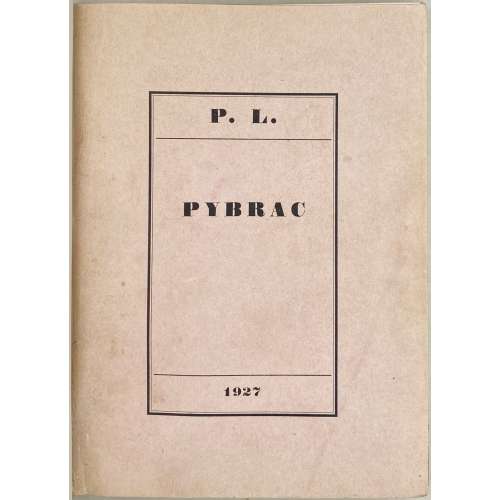 Description: Hardcover, 19.3 x 15 cm, printed on thick wove paper watermarked “J. PERRIGOT MBM ARCHES (France)”, bound by Thomas Boichot (signed 'BOICHOT' on front pastedown) in silver buckram with a white floral diaper, original front wrapper preserved, top margin gilt; engraved bookplate of Roger Peyrefitte by Pierre-Yves Trémois, 1972, to front pastedown lettered “SEX | LIBRIS | ROGER | PEYREFITTE | {vignette} | Trémois | 72”; bookplate of J.-P. Dutel to binder’s flyleaf. Description by the seller: Plein papier à la Bradel, tête dorée, non rogné, premier plat de couverture conservé. (Boichot). Édition originale publiée en 1927 par René Bonnel ornée dans le titre d’une vignette gravée par Foujita. Tirage : 5 ex. sur Japon ancien. 100 ex. sur vélin d’Arches. EXEMPLAIRE UNIQUE. UN DES 100 SUR VÉLIN D’ARCHES (N°97), ENRICHI DE 8 AQUARELLES LIBRES. Provenance: Roger Peyrefitte (Ex-libris érotique gravé par Trémois). Collation: Pink front wrapper, lettered in frame “P. L. |—| PYBRAC |—| 1927”, 2 blank leaves, [1] h.t., [1] t.p. in red and black with engraved vignette by Foujita, [2] (Sur la chemise…), [2] f.t. / blank, [5] 6-98 [2 colophon/blank], 2 blank leaves, total 52 leaves plus four blanks and a wrapper. Title-page (red and black): PIERRE LOUŸS | PYBRAC | POESIES | {vignette} | CYTHÈRE | AU COQ HARDI || Edition: Limited edition of 105 copies of which this is copy № 97 on Arches paper, enhanced with eight in-text colour drawings by an anonymous artist (unique copy). Another unique copy of the same edition illustrated by an anonymous artist in this collection LIB-3130.2023. Contributors: Pierre Louÿs (French, 1870 – 1925) – author. Léonard Tsuguharu Foujita (Japanese-French, 1886 – 1968) – artist (t.p. vignette). Roger Peyrefitte (French, 1907 – 2000) – provenance. Pierre-Yves Trémois (French, 1921 – 2020) – artist (bookplate) René Bonnel (French, 1884 – 1975) – publisher. Thomas Boichot – bookbinder.
Description: Hardcover, 19.3 x 15 cm, printed on thick wove paper watermarked “J. PERRIGOT MBM ARCHES (France)”, bound by Thomas Boichot (signed 'BOICHOT' on front pastedown) in silver buckram with a white floral diaper, original front wrapper preserved, top margin gilt; engraved bookplate of Roger Peyrefitte by Pierre-Yves Trémois, 1972, to front pastedown lettered “SEX | LIBRIS | ROGER | PEYREFITTE | {vignette} | Trémois | 72”; bookplate of J.-P. Dutel to binder’s flyleaf. Description by the seller: Plein papier à la Bradel, tête dorée, non rogné, premier plat de couverture conservé. (Boichot). Édition originale publiée en 1927 par René Bonnel ornée dans le titre d’une vignette gravée par Foujita. Tirage : 5 ex. sur Japon ancien. 100 ex. sur vélin d’Arches. EXEMPLAIRE UNIQUE. UN DES 100 SUR VÉLIN D’ARCHES (N°97), ENRICHI DE 8 AQUARELLES LIBRES. Provenance: Roger Peyrefitte (Ex-libris érotique gravé par Trémois). Collation: Pink front wrapper, lettered in frame “P. L. |—| PYBRAC |—| 1927”, 2 blank leaves, [1] h.t., [1] t.p. in red and black with engraved vignette by Foujita, [2] (Sur la chemise…), [2] f.t. / blank, [5] 6-98 [2 colophon/blank], 2 blank leaves, total 52 leaves plus four blanks and a wrapper. Title-page (red and black): PIERRE LOUŸS | PYBRAC | POESIES | {vignette} | CYTHÈRE | AU COQ HARDI || Edition: Limited edition of 105 copies of which this is copy № 97 on Arches paper, enhanced with eight in-text colour drawings by an anonymous artist (unique copy). Another unique copy of the same edition illustrated by an anonymous artist in this collection LIB-3130.2023. Contributors: Pierre Louÿs (French, 1870 – 1925) – author. Léonard Tsuguharu Foujita (Japanese-French, 1886 – 1968) – artist (t.p. vignette). Roger Peyrefitte (French, 1907 – 2000) – provenance. Pierre-Yves Trémois (French, 1921 – 2020) – artist (bookplate) René Bonnel (French, 1884 – 1975) – publisher. Thomas Boichot – bookbinder. -
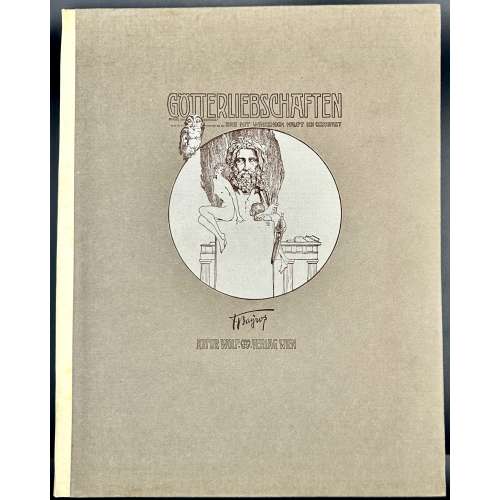 Letterpress title-page, engraved title-page, and 10 sheets of collotype plates printed on india paper mounted on thick wove paper, with captioned guard sheets, loose in a vellum-backed cardboard portfolio with cloth-mounted flaps; floral diaper design inside throughout; bookseller's label to front board verso; limited edition of 550 copies of which this is copy № 103. Dimensions: 338 x 268 mm portfolio; 325 x 260 mm sheet, 225 x 195 mm image. Front board with lettering and vignette: GÖTTERLIEBSCHAFTEN | DAS MIT WINKENDEM HAUPT ICH GEWAHRET | {vignette} | {signature} | ARTUR WOLF / VERLAG WIEN || Letterpress title-page: FRANZ VON BAYROS | “GÖTTERLIEBSCHAFTEN” | ARTUR WOLF / VERLAG WIEN | 1914 || Verso to letterpress t.p. VERZEICHNIS DER TAFELN.
Letterpress title-page, engraved title-page, and 10 sheets of collotype plates printed on india paper mounted on thick wove paper, with captioned guard sheets, loose in a vellum-backed cardboard portfolio with cloth-mounted flaps; floral diaper design inside throughout; bookseller's label to front board verso; limited edition of 550 copies of which this is copy № 103. Dimensions: 338 x 268 mm portfolio; 325 x 260 mm sheet, 225 x 195 mm image. Front board with lettering and vignette: GÖTTERLIEBSCHAFTEN | DAS MIT WINKENDEM HAUPT ICH GEWAHRET | {vignette} | {signature} | ARTUR WOLF / VERLAG WIEN || Letterpress title-page: FRANZ VON BAYROS | “GÖTTERLIEBSCHAFTEN” | ARTUR WOLF / VERLAG WIEN | 1914 || Verso to letterpress t.p. VERZEICHNIS DER TAFELN.- Europa und der Stier
- Leda und die Schildkröte
- Sterope und Herkules
- Herodikos und die Turnerinnen
- Phoroneus und die Hirtin
- Minos und Persipeia
- Phryne und Mutter
- Pytalos und Demeter
- Kirke und die Ferkel
- Putiphar
-
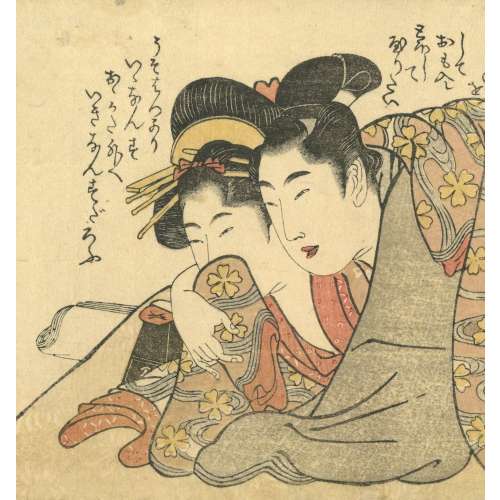 Artist: Kitagawa Utamaro [喜多川 歌麿] (Japanese, c. 1753 – 1806) "This uncommon half-size horizontal ōban ... is most likely one design from a set of twelve prints issued late in Utamaro's life" [Japanese Erotic Fantasies, Hotei Publishing, 2005, p. 143, pl. 47]. Half-size horizontal ōban must be 12.7 x 38 cm. Richard Waldman and Chris Uhlenbeck say it's tanzaku size (13 x 43 cm). In reality, the prints of this series measure 17 x 38 cm, which corresponds exactly to horizontal o-hosoban paper size. I managed to assemble 11 of allegedly 12 designs. 7 of them have genitals colored by hand. It's hard to tell whether it was done by the publisher on demand of a peculiar buyer, or by the owner of the prints who considered the black and white privy parts unnatural. My sequencing of the prints is arbitrary. Transcription of the text may help find the correct order.
Artist: Kitagawa Utamaro [喜多川 歌麿] (Japanese, c. 1753 – 1806) "This uncommon half-size horizontal ōban ... is most likely one design from a set of twelve prints issued late in Utamaro's life" [Japanese Erotic Fantasies, Hotei Publishing, 2005, p. 143, pl. 47]. Half-size horizontal ōban must be 12.7 x 38 cm. Richard Waldman and Chris Uhlenbeck say it's tanzaku size (13 x 43 cm). In reality, the prints of this series measure 17 x 38 cm, which corresponds exactly to horizontal o-hosoban paper size. I managed to assemble 11 of allegedly 12 designs. 7 of them have genitals colored by hand. It's hard to tell whether it was done by the publisher on demand of a peculiar buyer, or by the owner of the prints who considered the black and white privy parts unnatural. My sequencing of the prints is arbitrary. Transcription of the text may help find the correct order. As Japanese Erotic Fantasies put it: "a couple engaged in love-making, their stare fixed outside the picture plane". This is the only image of series that has a reference in available western literature, and the only one found in museum collections: Rijksmuseum Amsterdam (RP-P-1999-2001-16); reference: Fukuda (ed.) (1990), pls. 11-2.
As Japanese Erotic Fantasies put it: "a couple engaged in love-making, their stare fixed outside the picture plane". This is the only image of series that has a reference in available western literature, and the only one found in museum collections: Rijksmuseum Amsterdam (RP-P-1999-2001-16); reference: Fukuda (ed.) (1990), pls. 11-2.
 The scene of this print looks quite similar to that of the Kiyonaga's Sode no maki:
The scene of this print looks quite similar to that of the Kiyonaga's Sode no maki:
 The woman is "a young lady-in-waiting of Shogun's Court or Daimyō's Mansion, enjoying a rare outing from her tedious chores" [Richard Lane]. She is fully dressed in her outer cloak (shikake), white paper hat (agebōshi or tsunokakushi), and toed socks (tabi). A book or maybe, onkotogami (roll of tissues known as 'paper for honourable act' ) is still in the folds of her kimono. She is holding an open fan, either to cover her and her lover's faces from an unsolicited witness or to bring some fresh air to their joined lips. The pair just started their sexual intercourse.
The woman is "a young lady-in-waiting of Shogun's Court or Daimyō's Mansion, enjoying a rare outing from her tedious chores" [Richard Lane]. She is fully dressed in her outer cloak (shikake), white paper hat (agebōshi or tsunokakushi), and toed socks (tabi). A book or maybe, onkotogami (roll of tissues known as 'paper for honourable act' ) is still in the folds of her kimono. She is holding an open fan, either to cover her and her lover's faces from an unsolicited witness or to bring some fresh air to their joined lips. The pair just started their sexual intercourse.
 A scene from medieval times. A courtier in eboshi cap having sex with an aristocratic young woman with a long straight hairstyle (suihatsu).
A scene from medieval times. A courtier in eboshi cap having sex with an aristocratic young woman with a long straight hairstyle (suihatsu).
 Completely naked couple in the moment of ejaculation. Lavish garments with paulownia leaves on a yellow background counterbalance the white bodies on red bedding. The form of a woman's cheeks is telling, but I don't know about what. Maybe her advanced age?
Completely naked couple in the moment of ejaculation. Lavish garments with paulownia leaves on a yellow background counterbalance the white bodies on red bedding. The form of a woman's cheeks is telling, but I don't know about what. Maybe her advanced age?
 The pose of the couple and the overall composition are similar to that of the previous sheet. Though the lovers are dressed, and the woman's hairdo is well kept. The male looks older and the woman - younger.
The pose of the couple and the overall composition are similar to that of the previous sheet. Though the lovers are dressed, and the woman's hairdo is well kept. The male looks older and the woman - younger.
 A man takes a young maid from behind. She clenches the sleeve of her kimono in her teeth; it's either the moment of penetration (beginning of intercourse) or of her orgasm (the end of it).
A man takes a young maid from behind. She clenches the sleeve of her kimono in her teeth; it's either the moment of penetration (beginning of intercourse) or of her orgasm (the end of it).
 This seems to be a forced intercourse between a lackey with extensive bodily hair and a young maid from the same household.
This seems to be a forced intercourse between a lackey with extensive bodily hair and a young maid from the same household.
 This design is very much like the other one presented below, which is described at Japanese Erotic Fantasies on page 136 (pl. 43b) as follows: "The viewer peers through a mosquito net to see a child fast asleep, while his mother or wet-nurse moves towards her partner. On our print there is no child; instead of a sleeping baby, there is a roll of onkotogami. Fewer objects make the overall image concise, almost laconic in comparison with the Ehon hana fubuki (1802) design:
This design is very much like the other one presented below, which is described at Japanese Erotic Fantasies on page 136 (pl. 43b) as follows: "The viewer peers through a mosquito net to see a child fast asleep, while his mother or wet-nurse moves towards her partner. On our print there is no child; instead of a sleeping baby, there is a roll of onkotogami. Fewer objects make the overall image concise, almost laconic in comparison with the Ehon hana fubuki (1802) design:

 A young couple in a moment of true love. He is listening to the beating of her heart.
A young couple in a moment of true love. He is listening to the beating of her heart.
 This is a moment of true love between an old monk and a young samurai. The latter even did not take of his socks (tabi).
This is a moment of true love between an old monk and a young samurai. The latter even did not take of his socks (tabi).
 From Japanese Erotic Fantasies: "Boats played a crucial role in the workings of Yoshiwara, as they were the primary means of transport to the district. During the hot summer months, trips on pleasure boats were also a favourite pastime. Sex aboard a boat is a recurrent theme in shunga".
The last print that I am currently lacking and hunting for:
From Japanese Erotic Fantasies: "Boats played a crucial role in the workings of Yoshiwara, as they were the primary means of transport to the district. During the hot summer months, trips on pleasure boats were also a favourite pastime. Sex aboard a boat is a recurrent theme in shunga".
The last print that I am currently lacking and hunting for:
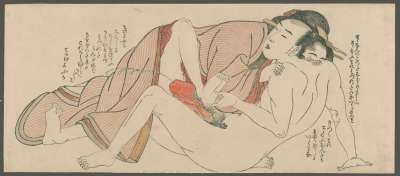 I know where it is, but I cannot reach it... yet.
I know where it is, but I cannot reach it... yet. -
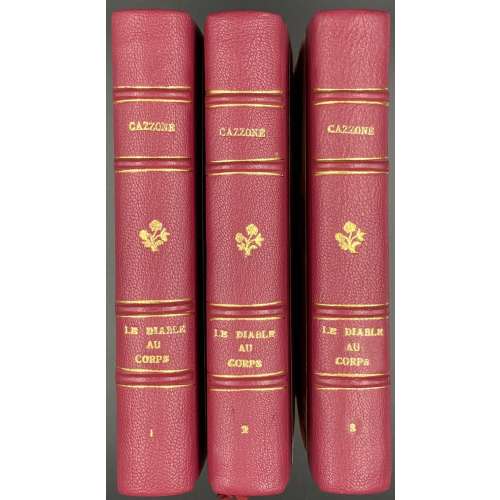 Description: Three volumes, 17 x 14 cm each, uniformly bound in quarter crimson morocco over marbled boards, spine with raised bands tooled gilt with gilt lettering and fleuron, marbled endpapers, publisher’s wrappers preserved (moire-waffle in light pink (vol. 1), cream (vol. 2) and blue (vol. 3), engraved), printed on wove paper, outer and bottom margin untrimmed, illustrated with etched/aquatint front wrapper, frontispiece, tail- and headpieces, and full-page plates in sepia, presumably after Zyg Brunner. Title-page (red and black): LE DIABLE | AU | CORPS | ŒUVRE POSTHUME | DU TRÈS RECOMMANDABLE DOCTEUR | CAZZONÉ | (ANDRÉA DE NERCIAT) | Membre extraordinaire de la joyeuse Faculté | phallo-coîro-pygo-glottonomique | TOME PREMIER (DEUXIÈME; TROISIÈME) | ALENÇON | 1930 || Vol. 1: front wrapper, blank leaf, h.t./limitation, t.p., [1] 2-180, 2 blank leaves, back wrapper; frontispiece, 7 full-page plates (incl. frontispiece), and 13 tail- and headpieces. Vol. 2: front wrapper, blank leaf, h.t./limitation, t.p., [1] 2-193 [194 blank], blank leaf, back wrapper; 8 full-page plates (incl. frontispiece), and 12 tail- and headpieces. Vol. 3: front wrapper, blank leaf, h.t./limitation, t.p., [1] 2-180 [181 colophon], [182 blank], blank leaf, back wrapper; frontispiece, 8 full-page plates (incl. frontispiece), and 13 tail- and headpieces. Limitation: 30 copies (№ 1-30) on Japon Impérial, 300 copies (№ 31-331) on Vélin d’Arches. This copy is № 109. Colophon: Printed on May 25, 1930, 350 copies on Vélin d’Arches with numbers from 31 to 380 [sic!] Catalogue raisonné: Dutel (1920-1970) № 1394, p. 129. Contributors: André-Robert Andréa de Nerciat (French, 1739 – 1800) – author. Zyg [Zygismund; Sigismond Leopold] Brunner (Polish, 1878 – 1961) – artist.
Description: Three volumes, 17 x 14 cm each, uniformly bound in quarter crimson morocco over marbled boards, spine with raised bands tooled gilt with gilt lettering and fleuron, marbled endpapers, publisher’s wrappers preserved (moire-waffle in light pink (vol. 1), cream (vol. 2) and blue (vol. 3), engraved), printed on wove paper, outer and bottom margin untrimmed, illustrated with etched/aquatint front wrapper, frontispiece, tail- and headpieces, and full-page plates in sepia, presumably after Zyg Brunner. Title-page (red and black): LE DIABLE | AU | CORPS | ŒUVRE POSTHUME | DU TRÈS RECOMMANDABLE DOCTEUR | CAZZONÉ | (ANDRÉA DE NERCIAT) | Membre extraordinaire de la joyeuse Faculté | phallo-coîro-pygo-glottonomique | TOME PREMIER (DEUXIÈME; TROISIÈME) | ALENÇON | 1930 || Vol. 1: front wrapper, blank leaf, h.t./limitation, t.p., [1] 2-180, 2 blank leaves, back wrapper; frontispiece, 7 full-page plates (incl. frontispiece), and 13 tail- and headpieces. Vol. 2: front wrapper, blank leaf, h.t./limitation, t.p., [1] 2-193 [194 blank], blank leaf, back wrapper; 8 full-page plates (incl. frontispiece), and 12 tail- and headpieces. Vol. 3: front wrapper, blank leaf, h.t./limitation, t.p., [1] 2-180 [181 colophon], [182 blank], blank leaf, back wrapper; frontispiece, 8 full-page plates (incl. frontispiece), and 13 tail- and headpieces. Limitation: 30 copies (№ 1-30) on Japon Impérial, 300 copies (№ 31-331) on Vélin d’Arches. This copy is № 109. Colophon: Printed on May 25, 1930, 350 copies on Vélin d’Arches with numbers from 31 to 380 [sic!] Catalogue raisonné: Dutel (1920-1970) № 1394, p. 129. Contributors: André-Robert Andréa de Nerciat (French, 1739 – 1800) – author. Zyg [Zygismund; Sigismond Leopold] Brunner (Polish, 1878 – 1961) – artist.


